Guide To Masts, Yards & Booms On Model Ships
- Updated on:
- Written by Gary Renshaw
In this post we will be considering the various masts and yards used on a wooden period model ship and their fittings. We will also examine techniques to taper the masts and yards.
Masts
It is important to construct the masts and yards and attach all the associated fittings to your model. This will make the whole assembly process easier.
The masts on smaller vessels were one piece or made up of two sections the lower mast and the topmast. In larger vessels, the masts were made up of three sections— lower mast, topmast and topgallant mast.
On real ships, the masts were made from multiple pieces of timber that were shaped to be interlocked together which provided great strength in the mast.
In modelling, the different mast sections are made from a single length of dowel. The dowel commonly used for masts and yards is usually either Ramin, birch, walnut or mahogany.
Where the respective mast sections are joined caps and cross trees and trestles are used the attach the mast sections together.
The lower mast rose to the trestle trees and cross trees on which was mounted the top. The top was a platform for various gear on which the crew worked. The trestle trees supported the heel of the topmast which rose through the cap of the lower mast.
The section where the lower mast and the top mast overlapped was called the doublings.
Above the topmast was rigged the topgallant mast. For larger vessels the next higher mast was the royal mast, then the sky sail mast and finally, for the largest of 19th century ships was the moon sail mast.
In this chapter, we will limit our discussion to the three masts presented in Figure 1.
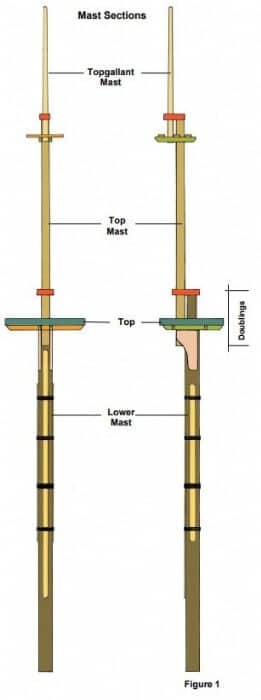
The front and side elevations of the mast sections are identified in Figure 1.
It is most important to assemble the masts and fit all eye pins and blocks before fixing the mast to the model. The location of all eye pins and blocks on the masts will be presented on the plans in the kit.
Each of the parts is presented in more detail below.
Mast Structures
Trestle Trees & Cross Trees
Trestle trees are two strong bars of timber fixed horizontally fore-and-aft on each side of the lower masthead, to support the topmast, lower cross-trees, and mast top. Smaller trestle trees are fitted on the topmast head to support the topgallant mast and topmast cross-trees.
Cap
The Cap was a strong thick block of wood with two large holes through it, one square and the other round. The cap was used to confine two masts together when one is erected at the head of the other in order to lengthen it.
Cheeks
Mast cheeks were fitted fore-and-aft either side of the lower masthead. The trestle trees rested on the top of the mast cheeks.
Wooldlings
Woodlings were iron hoops or heavy rope lashings to reinforce the mast.
Strengtheners (or fish)
Strengtheners were lengths of timber lashed to three sides of the mast to give added strength and flexibility to the mast.
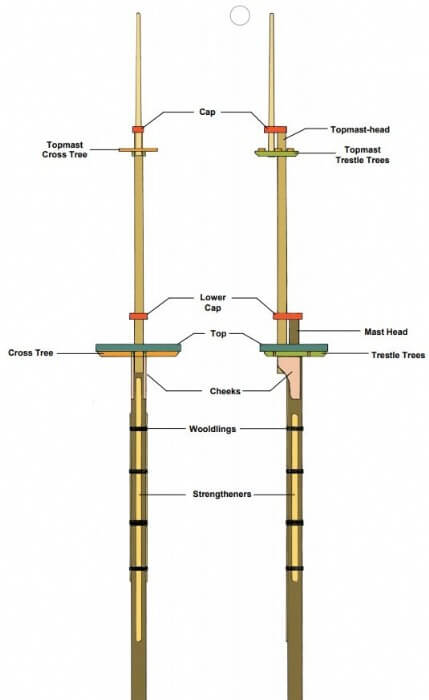
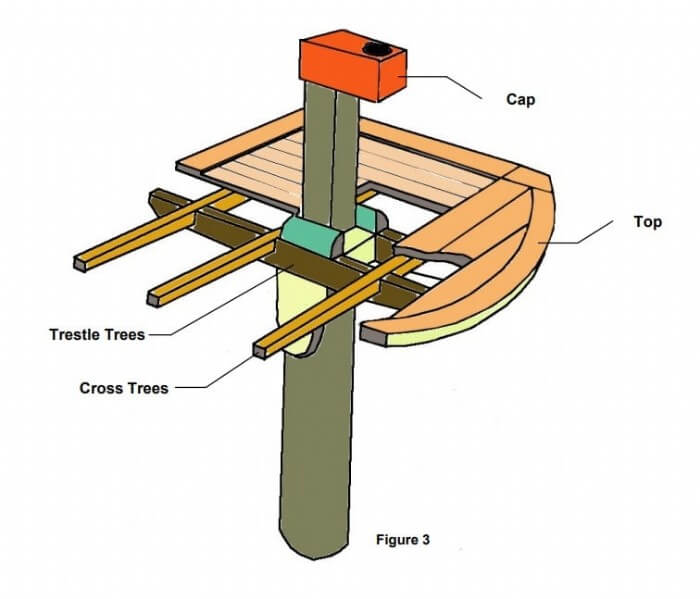
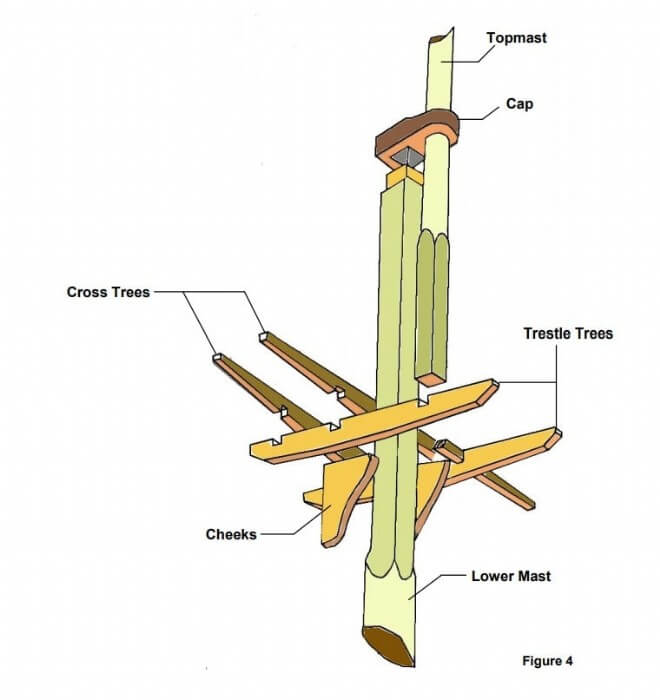
Masts on Vessels
Sailing vessels had from one to several masts. Generally though the wooden model ship kits you will most commonly encounter will one, two or three masts. The bowsprit on a vessel is another form of mast projecting out from the bow of the vessel. Bowsprits will be dealt with separately later in this chapter. For a vessel with one mast the mast was simply called the Mast
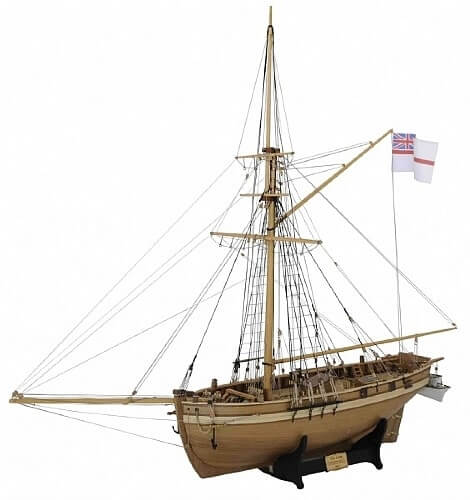
For a vessel with two masts—starting from the bow they are called Fore Mast and Main Mast. The main mast is always the taller.
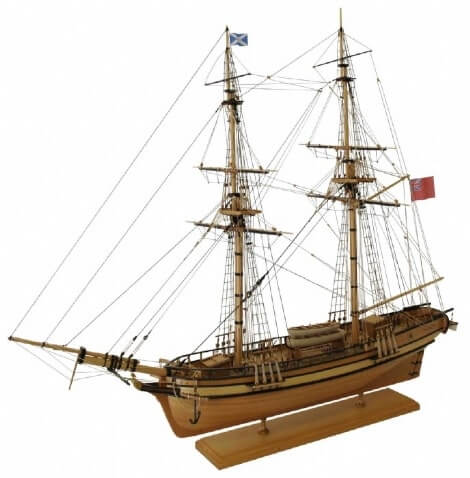
For a vessel with three masts—starting from the bow they are called Fore Mast, Main Mast and Mizzen Mast. The mizzen mast is always the shortest mast.
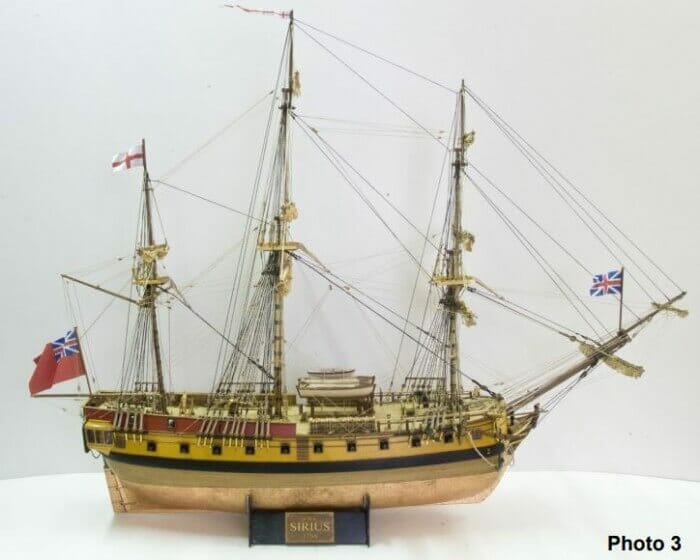
Bowsprit
The bowsprit on a vessel is another form of mast projecting almost horizontally out from the bow. On small vessels the bowsprit was a single length of timber. On larger vessels there were extensions to the bowsprit called the jib-boom and flying jib-boom. The various extensions to the bowsprit were joined by a cap and rope gammoning.
The bowsprit was used to support a range of rigging which will be discussed in the Rigging chapter.
On some vessels a small yard called the Spritsail Yard was attached to the underside of the bowsprit.
Also on some vessels a short gaff-shaped spar is fixed perpendicularly under the cap of the bowsprit. This is called the Martingale or Dolphin Striker. It is used to guy the jib-boom in place.
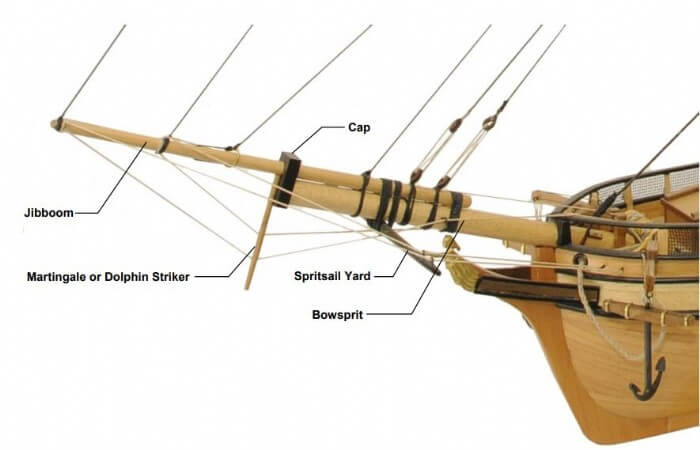
Yard Identification
A yard is a long cylindrical length of timber suspended from the mast of a vessel to spread a sail.
The yards were named according to where they were attached to the mast. For example:
- The yard attached to the lower mast was named the Yard.
- The yard attached to the top mast was named the Top Yard.
- The yard attached to the topgallant mast was named the Topgallant Yard.
- For larger vessels the higher yards were named accordingly.
Then the yards were further named according to the mast to which they were attached. For example the yards on the foremast of the vessel in Photo 5 were named Fore Yard, Fore Top Yard and Fore Topgallant Yard.
Yards on the main mast were named Main Yard, Main Top Yard and Main Topgallant Yard.
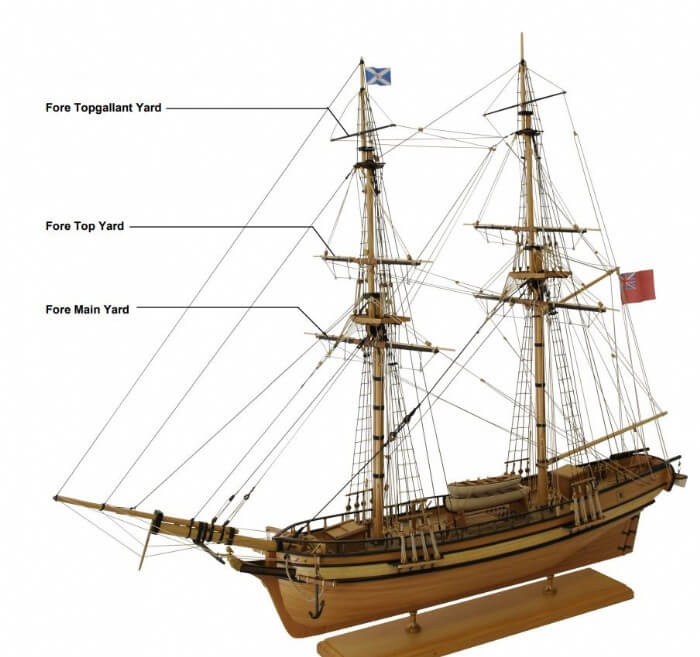
Yards
A yard was fitted with a range of parts. These are presented in Figure 5 along with their respective purpose.
Block: Used as part of running rigging to adjust the angle of the yard.
Jeer Blocks: Larger blocks used to raise the yard. Smaller yards may have one block.
Pendant & Block: Used as part of the running rigging to adjust the angle of the yard.
Foot Rope Stirrup & Foot Rope: Stirrup used to support the foot rope. Sailors would use the foot rope for support as they moved along the yard to furl or unfurl the sail. The foot ropes were always left slack.
Studding sail yard Studding sail yard: Used to extend beyond the yard end and have the studding sails attached. Studding sails were used in fair weather to add additional sail area to the vessel.

Refer to your kit plans to determine the dowel size and length for each yard. Shape accordingly and fit all the parts to each mast.
Boom and Gaff
The boom and gaff replace yards on fore-and-aft rigged sails. For a schooner, the boom and gaff hold the fore and mainsails. For a square rigged vessel the boom and gaff support the driver sail.
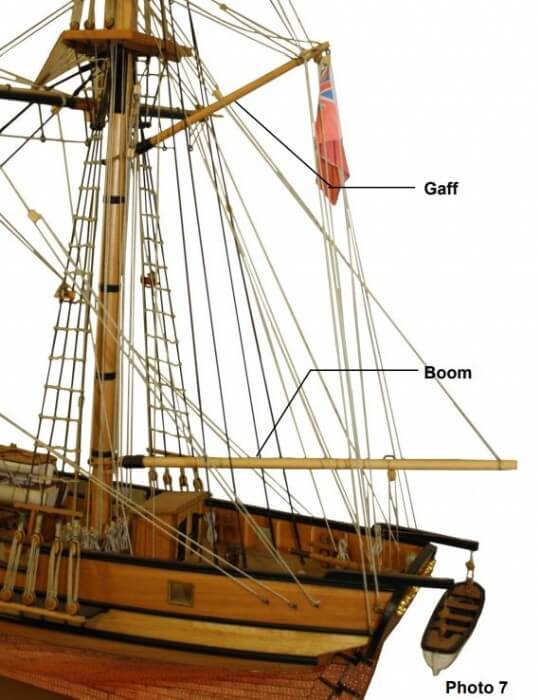
The boom and gaff are often tapered at one end only. The boom and gaff are secured to the mast by a yoke. The jaw of the yoke encircles approximately half the circumference of the mast and are secured by the use of parrel beads tied at each end of the yoke jaws.
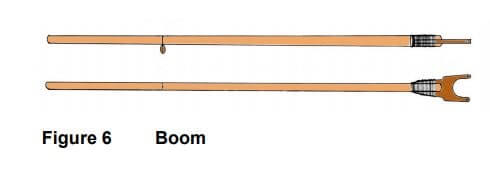
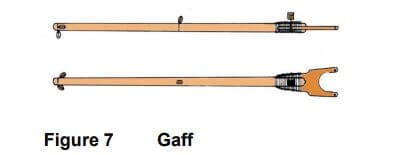
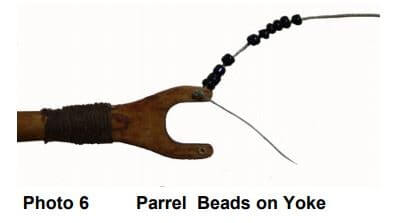
Tapering Masts, Yards and Booms
In a wooden model ship kit you will be supplied with dowels of various diameter to make these parts. The dowel commonly used for masts and yards is usually either, ramin, birch, walnut or mahogany.
Check your dowels for straightness . Sometimes you may find a length of dowel has warped in which case it will need to be replaced.
In your set of kit plans you will find drawings with all the dimensions for the respective lengths of masts and yards. Be careful with these drawings as sometimes they are not to scale. The drawings will always identify the name of the item, its length and the relevant diameter at each end.
The dowels in a kit are very rarely pre-cut to their required lengths. So It is most important that for a particular diameter dowel you identify all the items that have to be cut from the lengths provided in the kit. Sometimes in a kit you will have more than one length of dowel of the same diameter but it will be of different lengths. If you are not careful when cutting your mast or yard lengths from this diameter dowel you may find yourself short. To avoid the chance of this happening use a pencil to mark out on the dowel the lengths to be cut. Only when you are sure you will be able to make all the parts required from the stock of dowel supplied will you then cut your dowel lengths.
The masts and yards have to be tapered. There are a number of ways to taper the masts and yards
Lathe
The ideal way to taper the dowels is to use a lathe. This however is an expensive option. If you do choose to use a lathe it is most important to follow the lathe manufacturer’s safety instructions at all times, wear a safety face mask or safety glasses, ear protection and make sure any long hair is tied safely back and loose clothing is made secure.
A less expensive alternative to the lathe is to use a variable speed pistol drill placed in a bench vice. Make sure to set the drill speed at mid-range. The same lathe safety principles apply to using this method.
When using a lathe to taper your dowels first use a flat file followed by medium grade sandpaper. Continually stop the lathe and use a vernier caliper to take measurements . Use the sandpaper to make fine adjustments to the required diameter. Finally use a fine grade sandpaper to finish off the dowel.

Mini Plane
A simple and cost effective way to taper the dowels is to use a mini plane. By continually applying the plane to the dowel to create a number of flat sides and then using a coarse sandpaper to finish the tapering an excellent job can be achieved. Continually checking the diameter with a vernier calliper and finishing off with a fine grade sandpaper will ensure the correct diameters are achieved.
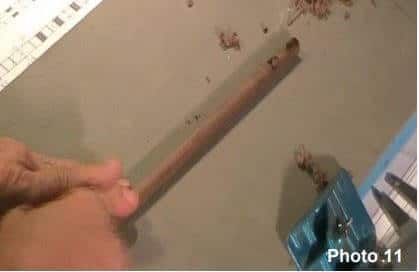

Learn The Art Of Building A Model Ship
Get started in wooden model ship building today









